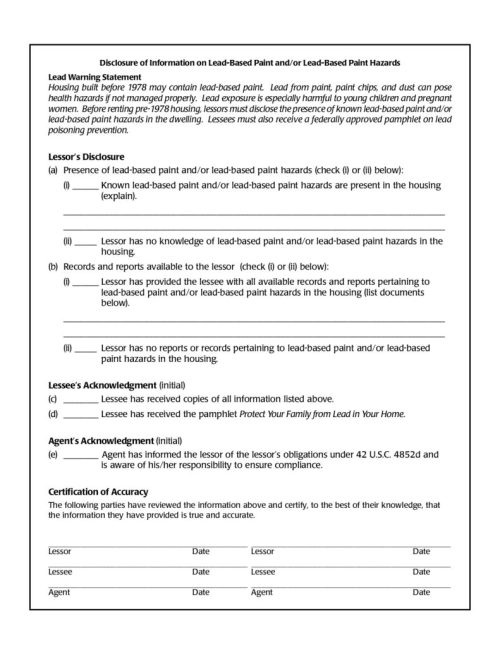A lead-based paint disclosure form is a federally mandated document in the United States designed to inform potential renters or buyers about the risks associated with lead-based paint in residential properties. This requirement stems from the Residential Lead-Based Paint Hazard Reduction Act of 1992. In essence, if a residential property was constructed before 1978, the year when lead-based paint was banned for consumer use, landlords and sellers are obligated to disclose any known presence of this paint or its associated hazards.
HUD and EPA Guidelines on Lead-Based Paint Disclosure
- Disclosure of Known Hazards: Landlords and sellers must disclose any known information about lead-based paint or related hazards in the property.
- Provision of Records and Reports: Any available records or reports concerning lead-based paint hazards must be provided to potential renters or buyers.
- EPA Pamphlet Distribution: Landlords and sellers must give potential renters or buyers an EPA-approved pamphlet titled “Protect Your Family from Lead in Your Home,” which educates about the dangers of lead-based paint.
- Signed Acknowledgment: Renters or buyers must sign an acknowledgment form confirming they received all the necessary information and the EPA pamphlet.
Exceptions to the Disclosure Requirement
- Housing built after January 1, 1978.
- Housing for the elderly or disabled (unless a child resides or is expected to reside there).
- Zero-bedroom dwellings (e.g., lofts, efficiencies, studios).
- Short-term rentals (less than 100 days).
Checking Your Home for Lead
- Visual Inspection: Check for chipping, peeling, or deteriorating paint.
- Lead Dust Test: Use a lead dust test kit available at home improvement stores.
- Professional Inspection: Hire a certified lead inspector or risk assessor to check your home. You can search for the nearest EPA-certified abatement firm by visiting the EPA’s website.
Tenant Rights Regarding Lead-Based Paint
- Right to Disclosure: Before signing a lease, tenants have the right to know about any known lead-based paint or hazards in the property.
- Receipt of EPA Pamphlet: Tenants must receive the “Protect Your Family from Lead in Your Home” pamphlet.
- Review of Reports: If available, tenants have the right to review any reports related to lead-based paint in the property.
EPA Pamphlet
The EPA's pamphlet, mandatory alongside the lead-based paint disclosure form, informs about the dangers of lead in homes built before 1978. It emphasizes lead-based paint risks, prevention tips, and landlords' disclosure duties, serving as an essential guide for safe housing.
Frequently Asked Questions
- How does lead-based paint affect health?
- Is it mandatory for landlords to remove lead-based paint?
- What should I do if I suspect lead paint in my rental property?
- Are there penalties for landlords who don't comply with the Lead-Based Paint Act?
- Can I break my lease if I discover undisclosed lead paint in my rental?
How does lead-based paint affect health?
Prolonged exposure to lead, especially in children, can lead to developmental issues, learning disabilities, and other health complications.
Is it mandatory for landlords to remove lead-based paint?
While landlords must disclose its presence, they aren’t always required to remove it. However, they must address peeling or chipping paint in properties with known lead-based paint.
What should I do if I suspect lead paint in my rental property?
If your home was built before 1978 and you suspect lead paint, consider getting a professional assessment. Inform your landlord if you find any hazards.
Are there penalties for landlords who don't comply with the Lead-Based Paint Act?
Yes, landlords who fail to provide the necessary disclosures can face significant fines and legal consequences.
Can I break my lease if I discover undisclosed lead paint in my rental?
If a landlord didn’t provide the required disclosure, it might be possible to break the lease. However, it’s essential to consult with legal counsel in such situations.

